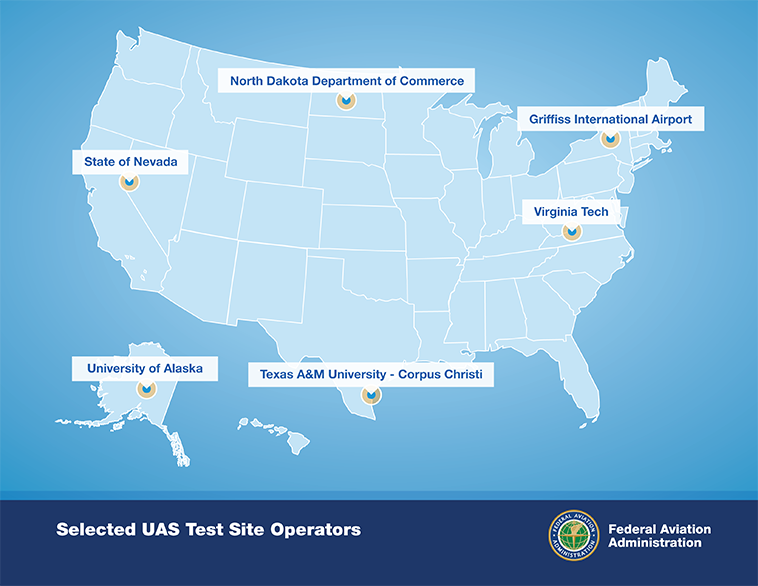If you would like to receive the Weekly Roundup in your inbox, please subscribe at the bottom of the page.
At the Center for the Study of the Drone
In an attempt to curb the recent resurgence of violence in Iraq, the U.S. is secretly sending ScanEagle surveillance drones to the country. Dan Gettinger examines this remarkable small drone and finds out why it is one of the most prolific unmanned aircraft ever made.
The American Federal Aviation Administration has announced its selection of six locations and organizations in Alaska, New York, North Dakota, Texas, Virginia and Nevada to serve as approved drone test sites. The test sites are intended to drive the development of systems and technologies for safely integrating drones into American airspace. The sites are a crucial part of the FAA’s efforts to establish rules and frameworks for unmanned aerial vehicle use. (The New York Times)
New York’s Syracuse-based, FAA-designated test site has already secured its first customer. Flyterra, a company based in New York City, sells aerial imagery to customers in the agriculture, mining, natural gas and oil industries. (Syracuse Post-Standard)
The New Jersey State Legislature has passed a bill that sets limits to how aerial footage collected by drones can be used. Specifically, the bill restricts the use of drones by law enforcement and public safety officials. In a position paper delivered to state lawmakers, the New Jersey Press Association raised concerns that the bill hampers journalists’ access to information collected by drones. (The Record of Bergen County)
Meanwhile, the state legislature of Illinois passed a bill that restricts the use of drones that interfere with hunting and fishing activities. Despite the bill, animal rights advocates such as the People for the Ethical Treatment of Animals (PETA) plan to continue to fly their drones in search of illegal hunting. (International Business Times)
German military organizations and ranking members of the military called on the Parliament to support the purchase of surveillance and reconnaissance drones. In a cross-party agreement last November, German parliamentarians rejected the American targeted killing campaign and suspended the purchase of military unmanned aircraft. (TheLocal.de)
Heather Linebaugh, a former U.S. Air Force imagery analyst and geo-spatial analyst, offers a critical insider’s perspective on the American drone program. “The U.S. and British militaries insist that this is an expert program, but it’s curious that they feel the need to deliver faulty information, few or no statistics about civilian deaths and twisted technology reports on the capabilities of our UAVs,” writes Linebaugh.
At Popular Science, Kelsey D. Atherton visits the new drone testing grounds in North Dakota. “When I, along with four other journalists, traveled to the Roughrider State, I found a community united in avoiding the word ‘drone,’” writes Atherton.
At War is Boring blog, David Axe explains that the Pentagon left all the “cool stuff”—for example, unmanned stealth bombers—out of its recent report on the future of military drones.
The Washington Post’s Tim Craig profiles Imran Khan, the Pakistani politician who has led his party in a fierce fight against American drone operations.
The editorial board of the New York Times contends that the FAA’s selection of drone sites must be accompanied by comprehensive and meaningful regulation of drone use. “Like many new technologies, drones pose both opportunities and challenges,” write the editors. “The aircraft, which can range widely in size from less than a pound to more than 30,000 pounds, can be incredibly useful but also very dangerous.”
At Slate, Lily Hay Newman offers five examples of how drones “could do some good in 2014.” The list includes applications such as environmental conservation and delivery of medical supplies to disaster areas.
In his ongoing series at Motherboard/Vice about the Federal Bureau of Investigation’s use of drones, Shawn Musgrave writes that the FBI “doesn’t have a solid grasp on basic measures, like how often it’s used drones, or which agents are certified to fly them.”
The January issue of the U.K.-based journal Radical Philosophies includes Derek Gregory’s essay “Drone Geographies.” Gregory argues that drones, despite having made a difference in the conduct of late-modern war, “cannot be severed from the matrix of military and paramilitary violence of which they are but a part.”
The Bureau of Investigative Journalism reviews American drone strikes in 2013. “In Yemen … at least 11 civilians including 4 children died in confirmed drone attacks. This steep rise from previous years was despite the number of confirmed strikes halving since 2012,” write Alice K. Ross and Jack Serle.
The War on the Rocks blog features a podcast discussion on “Counter-terrorism, Drones, Syria and More.”
In Foreign Affairs Magazine, Robert Farley argues that the United States no longer needs an air force. “Advocates of an independent air force had misinterpreted the lessons of World War II to draw faulty conclusions about air power’s future,” writes Farley.
At Los Angeles’ KCRW, radio host Warren Olney reviews the ways in which robots interact with humans today and the role they will play in our social environments in the future.
Know Your Drone
Artist and inventor Marque Cornblatt has designed a quadcopter drone that can fly through fire, break through glass windows, survive 400 ft free-falls and withstand a direct shot from a shotgun. (Youtube)
The Beijing Normal University and the Xinjiang Altun Mountain Nature Reserve will use drones to monitor the living conditions of yaks in the Altun Mountains. The yaks live in areas which are difficult to reach and they suffer from the effects of increased tourism in the region. (Motherboard/Vice)
Following numerous accidents, Indian authorities are considering whether to use drones to prevent trains from striking elephants in the northeast of the country. The proposed drones would monitor rail lines for pachyderms and alert conductors to slow down if a herd is spotted. (The Indian Express)
Meanwhile, the Indian armed forces will acquire 15 Israeli reconnaissance drones to monitor the country’s border with China. (Times of India)

